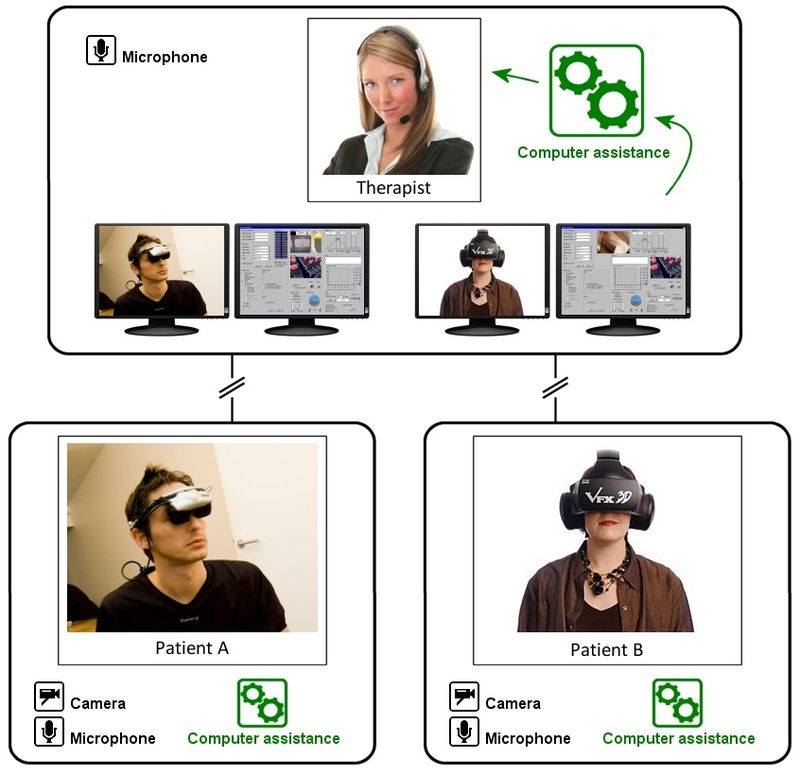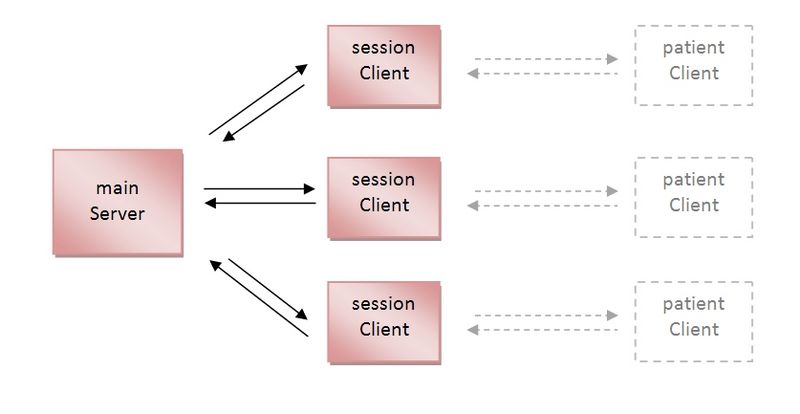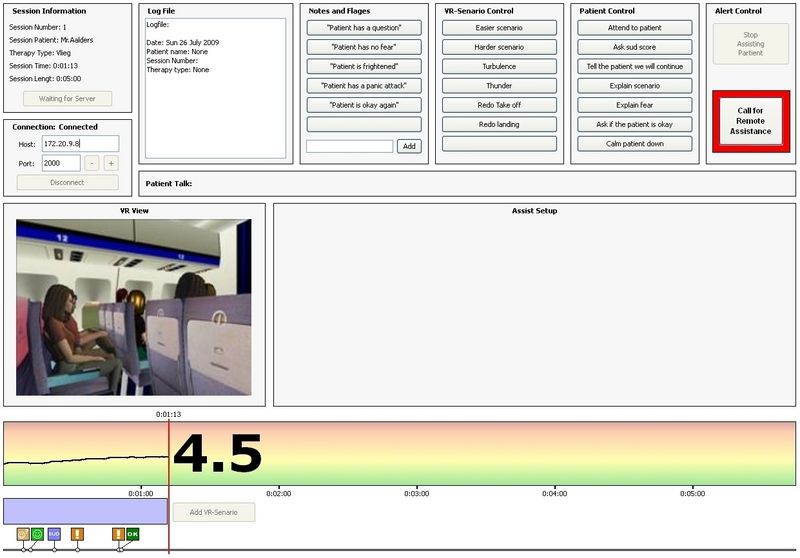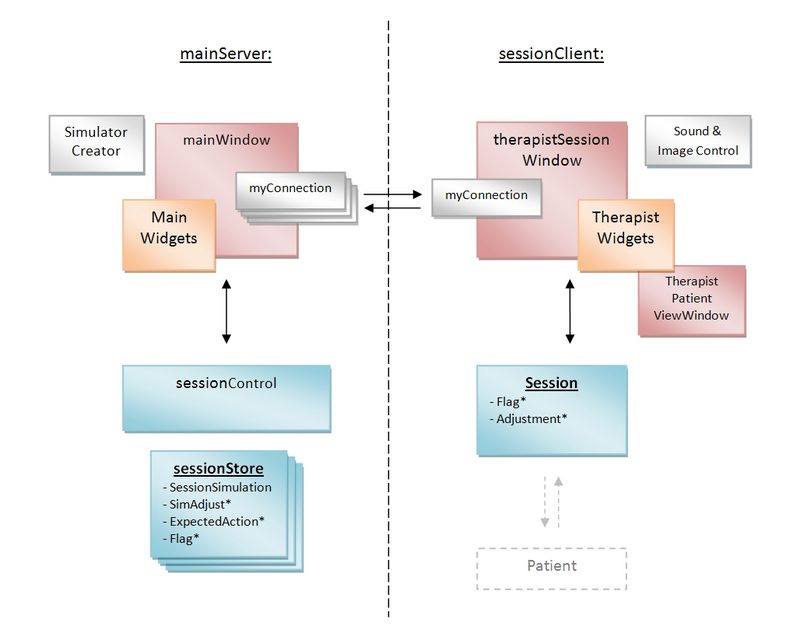Designing a Multiple patient VRET system
By Christian Paping, Tu-delft, Human-Computer Interaction
Promo video:
<anyweb>http://www.youtube.com/v/sSm9l8Al46A&hl=en&fs=1&</anyweb>
Abstract
The use of Virtual Reality (VR) technology to support the treatment of patients with phobia, such as the fear of flying, is getting considerable research attention. VR treatment may provide substantial improvement in efficient use of therapist resources and accessibility by delivering the treatment over the internet, to multiple patients simultaneously. This motivated initial exploration into the possibilities of a multiple patients Virtual Reality Exposure Treatment (VRET). With such a setup, one therapist can monitor and treat multiple patients simultaneously, each having their own personal VR treatment at their own personal location. The approach taken was (1) a scenario-based investigation with six therapists that had extensive experience in treating patients with VRET, and (2) a controlled lab experiment with 27 (students) participants to examine the effect of an automated assistance function on the therapists’ workload and performance when treating three computer-simulated patients over the internet. The findings of both the interviews and lab experiment are encouraging. They imply that a tele-delivered multi patient VRET system might be possible in the future, thereby providing treatment at remote locations and making efficient use of therapist resources.
Introduction
My research explores the possibility of one therapist treating two or more patients simultaneously with the VRET.
There are numerous reasons why exploring a multiple patient setup could be useful. First of all therapies are expensive and it could be possible that one therapist treating multiple patients in parallel could be a way to reduce the cost of the treatments. It could also be possible that fewer therapists can assist more patients, thus increasing the efficiency and accessibility of the treatments.
There are many different elements that are involved with the design of a multiple patient setup. Questions range from very practical, like where the patients will be located, does the patient need help putting the HMD on, to theoretical and psychological problems. For example, what are good ways for the therapist to cope with multiple patients at the same time and what factors influence the quality of this type of therapy.
Working with multiple patients simultaneously can eventually mean that the therapists might need assistance focusing their attention between patients. This could be done by implementing a computer system, between the patient and therapist, that continuously monitors the patients and warns the therapist if a patient needs attention. There is even the option of extending this system with modules that can take over specific tasks from the therapist if necessary.
Literature survey:
Literature survey to a multiple patient VRET system
Expert Interviews
Claims
1) Therapy structure
• After an initial interview with a therapist, the patient can be redirected to other therapists for a remote VRET session.
• Ten minutes at the beginning of a VRET session is enough for the therapist to welcome and assist the patient.
2) Remote communication setup
• It is not necessary in VR exposure treatment, that the therapist and the patient have physical contact.
• The therapist can assist the patient completely with only verbal communication.
• For emergencies an assistant on location is enough to provide backup assistance.
3) Patient data gathering and presentation to the therapist
• The therapist will always like to hear all voices from all patients.
• The therapist will always like to see all patients on their own personal monitors.
• The therapist does not mind working with multiple monitors at the same time.
• Patients will accept that a computer system will ask them for their SUD score.
• The use of physiological measurement has a large benefit in the monitoring of a patient.
4) Patient assistant system
• It is possible to create pre-programmed VR-scenario phases that can be varied from minimal anxiety provoking to maximal anxiety provoking.
• It is important that the therapist can link these scenario phases to a complete scenario.
• The therapist is capable, having all the background information of the patient, to select an fitting scenario for the patient.
5) Therapist warning and assist system
• The therapist wants to be able to configure the automated assist him or herself.
• The therapist wants to be able to configure the warning system him or herself.
• An automated assist can autonomously switch to an easier VR scenario if the anxiety-score of a patient is too high for a certain amount of time.
• An automated assist can autonomously witch to a harder VR scenario if the anxiety-score of a patient is too low for a certain amount of time.
• An automated assist system can automatically operate if a therapist does not react within a certain range of time.
Videos
The three videos, on average each taking about three minutes, show a therapist assist three patents with multiple patient VRET. The first video shows the start of a session and making contact with the first patient. It also shows how an assistant on location helps the patient with equipping their HMD and sensors.
The second video showed how a therapist can choose the different VR-scenarios for a patient. The last video shows how a therapist can setup an automated assist system and how it is working in general. The main goal of these videos is to use them in interviews with therapists, so they get a better understanding of multiple patient VRET and inspire them to start an discussion.
Scenario 1
<anyweb mywidth="300" myheight="200">http://www.youtube.com/v/4FBN_bBZePU</anyweb>
Scenario 2
<anyweb>http://www.youtube.com/v/cA0TIWbT0Yc</anyweb>
Scenario 3
<anyweb>http://www.youtube.com/v/XzeUAj4ssfE</anyweb>
.
The Prototype software
Python 2.6
PyQT 4.4.4-2
http://www.riverbankcomputing.co.uk/
Download the software:
download
press which buttons
Runing a Session (sessionClient)
...
Communication between sessions (mainServer)
...
over view objects
Server:
main.py
mainWidgets.py
sessionControl.py
sessionStrore.py
simulatorCreator.py
myConnection.py
Client:
mainTherapist.py
therapisWidgets.py
session.py
Adjustment
therapistSoundImageControl.py
myConnection.py
User testing
...
Results
. . .





